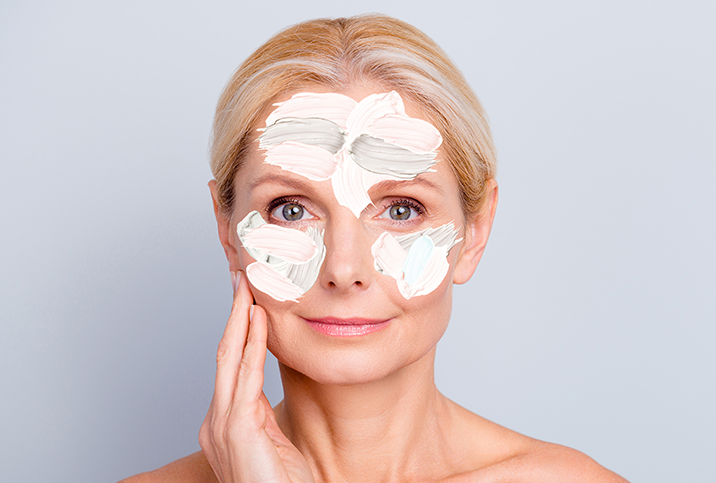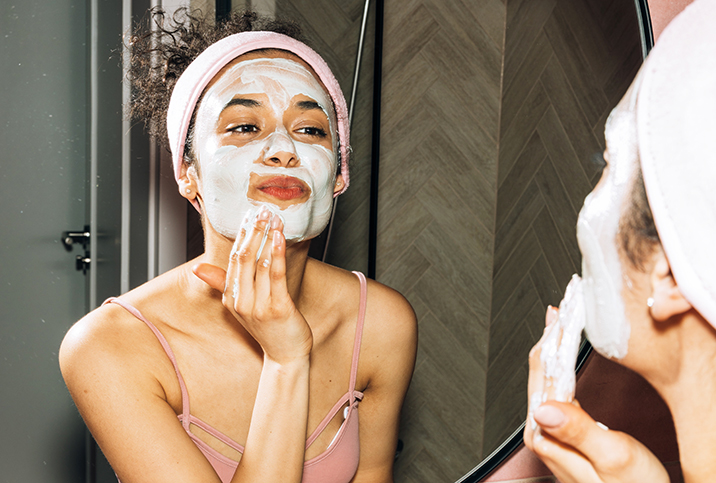The Period Skincare Routine You've Been Looking For

Many women notice changes to their skin throughout their menstrual cycle. The biggest concerns are hormonal acne, dry or oily skin and increased sensitivity. While these effects can seem like an unavoidable part of hormonal fluctuations, there is one way to manage them: cycle syncing.
Cycle syncing is the process of adapting your lifestyle and dietary choices to fit the different phases of your menstrual cycle. This process could mean adjusting your exercise routine, adding or cutting out certain foods and switching your skincare routine.
Why do skin changes occur?
Besides stress and poor diet, fluctuating hormones are the main reason skin changes occur.
"Hormones play a distinct role in the quality of a person's skin," said Nadir Qazi, D.O., a cosmetic dermatology surgeon and the founder of Qazi Cosmetic Clinic in Irvine, California. "Depending on the hormones, they can benefit the skin immensely or wreak havoc on it. Menstrual hormones can be especially tricky to navigate as they are constantly in flux."
Research shows that skin changes commonly occur around the time of menstruation. Acne, psoriasis, atopic eczema and irritant dermatitis are likely to be exacerbated. It's speculated this could be caused by reduced immune and barrier functions due to fluctuating progesterone and estrogen levels.
In addition, a 2015 study found evidence to suggest that skin redness decreases during menstruation, increases before ovulation and remains high during the luteal phase.
To understand how hormones change, it's simplest to discuss the four phases of your cycle: menstrual, follicular, ovulation and luteal.
Menstrual
Menstruation can be a difficult time in many ways, and some women notice a sudden acne flare-up around the time of their periods. There are a few reasons for this change.
During your period, you may feel sluggish and fatigued, which may cause you to eat more sugar, carbs and other convenience foods that can negatively affect your skin. A study published in 2017 revealed that nearly 50 percent of American women crave chocolate during their period. The sugar in chocolate can have pro-inflammatory effects on the skin, which can trigger or worsen acne.
Stress is another factor. Some women find that menstruation can be a stressful time, especially if they have to cancel plans or put activities and tasks on hold. An increase in stress can contribute to acne and other skin changes.
However, the most common reason for skin changes during menstruation is a sudden drop in hormones.
"During a menstrual phase, a person's skin may be drier and less vibrant," Qazi said. "When menstruating, there is a steep decrease in estrogen and progesterone that leaves the skin with less hydration and elasticity."
To make up for this loss of hydration, Qazi recommended supplementing with hyaluronic acid serums, which act as a humectant and draw hydration close to the skin cells for better absorption.
Use only mild cleansers and moisturizers with hyaluronic acid and ceramides, advised Beth Goldstein, M.D., a dermatologist and co-founder of Modern Ritual, a skincare company in Chapel Hill, North Carolina.
Exfoliators and peels should be avoided because they can aggravate the skin, Goldstein added.
Follicular
During the follicular phase, hormone levels begin to rise. A rise in testosterone and estrogen can increase sebum production, which can lead to acne flare-ups in many people, Goldstein said.
However, some people find their premenstrual acne starts to fade due to the increased estrogen. Estrogen stimulates collagen, elastin and hyaluronic acid, Qazi explained.
"Elastin and collagen are proteins that make skin firm and tight, and hyaluronic acid keeps it hydrated," Qazi said.
"With increased cell turnover, the dead skin cells begin to slough off, revealing the fresh skin underneath," Qazi said. "Because menstruation dries out your skin, the follicular phase can be an excellent time to use a mild exfoliant like mandelic acid to help eliminate the excess dead skin."
Ovulation
"The ovulation phase is very fast, 24 to 48 hours, usually occurring in the middle of the menstrual cycle," Qazi said. "During that time, a person's estrogen levels are at their highest to prepare for an egg to drop from the ovaries."
This sudden rise in estrogen can make your skin elastic, firm and glowing, Qazi continued. You don't need to avoid exfoliators or peels during this time. In fact, using an exfoliator is an effective way to keep pores free from buildup and prevent acne as you move into the luteal phase.
Luteal
The luteal phase, which lasts 12 to 14 days on average, is when progesterone levels spike and estrogen levels drop.
"The skin barrier is more permeable just prior to menstruation, which can cause increased sensitivity to products that one may tolerate during the earlier phases of menses," Goldstein said. "This can lead to an increased risk of both irritation and likelihood of dryness."
Half of all patients with eczema see a worsening of their skin condition in the week leading up to menstruation, Goldstein added.
During the luteal phase, you should use mild cleansers and moisturizers with hyaluronic acid and ceramides, while avoiding most exfoliators and peels. Qazi recommended gentle cleansers alongside mild exfoliants, such as salicylic acid or mandelic acid, which can help prevent breakouts.
If you're experiencing cysts or nodules that often occur in the week before your period, Goldstein recommended you speak to a dermatologist. Cyclical cysts and other skin issues can be treated with oral contraceptives, androgen-blocking therapies and low-dose intralesional steroids for individual lesions. Regular use of a topical antiandrogen may provide additional relief.
Give cycle syncing a try
If you've been struggling with skin conditions, such as acne or dry, flaky or peeling skin, it may be time to try cycle-syncing your routine. Talk to a dermatologist for personalized advice about the specific skincare challenges you've been facing.


















